
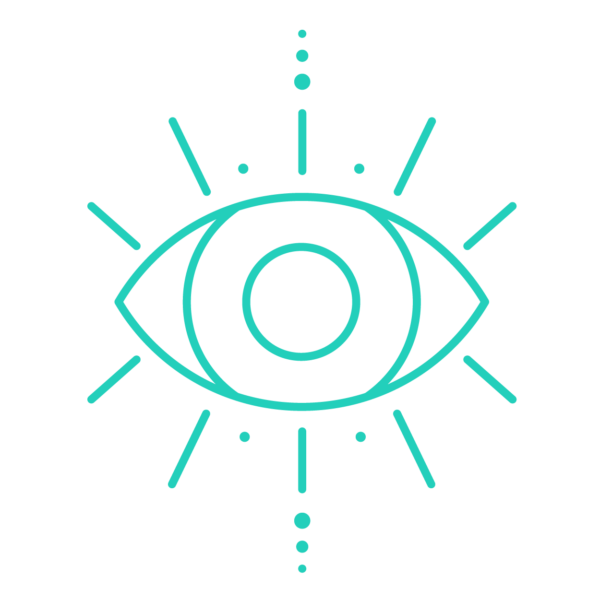

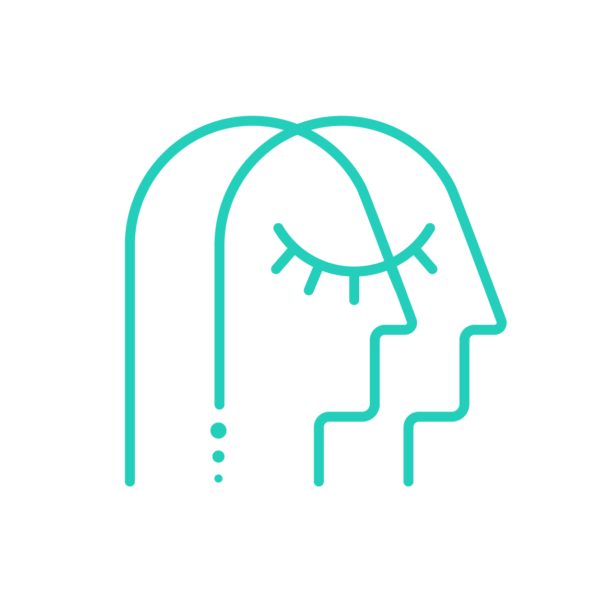

Neurofeedback is a non-invasive method of monitoring and training your brain waves through electronic equipment (typically EEG devices like the BrainLink Lite Headband) in order to evaluate your mind and body.
Neurofeedback therapy helps you become a more well-rounded person equipped to tackle adversity as well as enhances your mental fitness so you can enjoy a balanced life and healthy relationships. Neurofeedback equipment plays a key role in optimizing your mental fitness. Never before has capturing your brainwave data been so accessible!
With the right equipment in hand, you’re able to train your brain and the specific brainwave patterns associated with aspects of yourself you wish to improve.
However, as the popularity of this therapeutic tool continues to rise, many are curious about the options available to them when it comes to neurofeedback equipment, as well as how much said equipment (or therapy sessions in general) will end up taking out of their wallets.
We’ve put together the ultimate neurofeedback equipment buyer’s guide to answer all your questions.
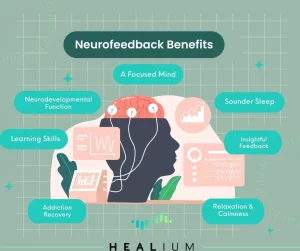 In our humble opinion, yes, very much so!
In our humble opinion, yes, very much so!
There’s no getting around the fact that neurofeedback can be costly depending on the approach you take (whether or not you do neurofeedback at home or go to a professional neurofeedback clinic makes a big difference in total cost).
However, the benefits that regular neurofeedback training can give you, especially when combined with immersive virtual reality meditation, are absolutely life changing and worth the investment.
– Insightful Feedback: Neurofeedback provides you with valuable feedback which will grant you insight into how your brain is working. Positive feedback is generated for healthy brain processes, while negative feedback is created for unhealthy brain processes.
– Relaxation and Calmness: Neurofeedback promotes relaxation by increasing your alpha waves, which can lead to a peaceful and relaxed state of mind. According to Forbes Health, alpha waves help control and treat anxiety and stress.
– A Focused Mind: Neurofeedback sharpens your focus by boosting your beta brain waves. These waves are connected to your alertness, attention span, and concentration. Beta waves play a role in the treatment of attention deficit hyperactivity disorder (ADHD).
– Sounder Sleep: Neurofeedback improves your sleep patterns and the quality of your sleep as a whole. In fact, neurofeedback therapy has grown in popularity as a drugless and self-managed way to help insomnia.
– Learning Skills: Neurofeedback training hones your learning skills by enhancing alpha wave activity. It can be used to manage and treat learning disorders like dyslexia and dyscalculia, based on a study published by the Basic and Clinical Neuroscience Journal.
– Neurodevelopmental Function: Neurofeedback improves neurodevelopmental functions, and can be instrumental in the treatment of autism, which limits your social ability and verbal and nonverbal communication activity.
– Addiction Recovery: Neurofeedback could help you to recover from drug and alcohol addiction and dependence. It can minimize your cravings for illicit substances, which could make you less vulnerable to the temptations of drugs or alcohol.
If you’re considering adding neurofeedback in your mental fitness toolkit, there are essentially two roads you can take: buying the proper equipment to practice neurofeedback at home, or finding a neurofeedback practitioner to conduct neurofeedback in a clinical setting.
Each of these routes has pros and cons, and each will have different associated costs.
Naturally, at-home neurofeedback devices grant you the benefits of neurofeedback training at a more affordable price point while staying put in the comfort of your own home. The drawback to this approach is that you’re reliant upon yourself to practice neurofeedback training correctly and regularly. If you can find the level of dedication required, this is often a great and affordable way to train your brain and build a consistent practice.
Alternatively, clinical neurofeedback therapy brings you a more in-depth and professional neurofeedback experience. Your neurofeedback therapy sessions will be overseen by a licensed professional who can help translate your brain data and direct you to further resources if needed. This approach to neurofeedback will be more costly, though, and depending on your location it could be difficult to locate a practitioner within feasible driving distance.
Let’s break down the equipment used for each approach a bit further:
There are a plethora of home neurofeedback devices on the market today. Some neurofeedback equipment you’ll find within a traditional medical setting, while others are more geared for users to experience the benefits of neurofeedback at home.
At Healium, we fall into the latter category.
At-home neurofeedback equipment are consumer-grade tools that can be used by non-professionals to undergo DIY neurofeedback therapy. Here are our favorite neurofeedback devices we recommend for those looking to experience neurofeedback for themselves.
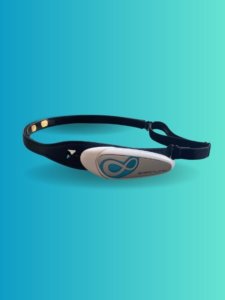
BrainLink or BrainLink Lite EEG headbands empower you to track your brain’s electrical activity via EEG sensors that are positioned on your forehead.
These soft leather headbands are the devices we recommend most often to new Healium users. They pair with both Healium AR and VR apps, providing users neurofeedback specifically for a focused calm state and improving sleep.
Wearing BrainLink Lite across the forehead provides a comfortable fit, is lightweight and adjusts to fit any head shape. Our favorite part? These devices are easy to grasp! There’s no crazy array of wires and sensors. Simply slip the band on your head, ensure it’s positioned properly and away you go. The fact that it is USB rechargeable is another added bonus.
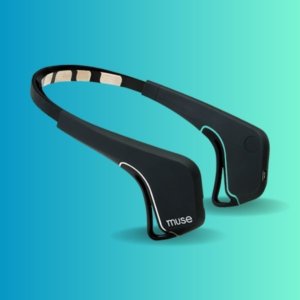 The Muse is a brain-sensing headband that can provide you with real-time biofeedback to help you refocus during the day and recover at night.
The Muse is a brain-sensing headband that can provide you with real-time biofeedback to help you refocus during the day and recover at night.
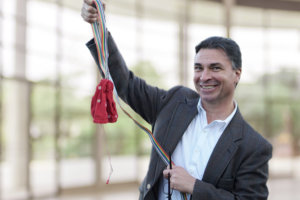 More than likely, this is what you’re picturing when you first think of “neurofeedback device”.
More than likely, this is what you’re picturing when you first think of “neurofeedback device”.
EEG headcaps contain electrodes that are applied to the scalp. The cap itself assists in electrode placement, allowing the electrodes to be placed precisely and maintain sufficient contact with the scalp.
Healium is a mental fitness app that utilizes virtual and augmented reality to reduce your stress and anxiety. The Healium experience is active, visual, and immersive, making it the ultimate meditation experience. Also, the foundation behind how it helps improve your brain is rooted in neurofeedback!
Our virtual reality experiences are directly affected by your heart rate and brainwaves via the BrainLink Lite EEG Headband. What’s more? The real-time brainwave chart (which we call the “firefly”) allows you a means to challenge and train specific brainwaves, while the data dashboard gives you the ability to track your progress over time.
Clinical studies have suggested that Healium can minimize moderate anxiety in as fast as four minutes.

Professional neurofeedback equipment is used by neurofeedback practitioners to provide neurofeedback therapy sessions to patients in medical centers. This type of equipment is only appropriate for professionals in the neurofeedback industry, and the equipment associated carries quite a hefty price tag.
These are some examples of professional neurofeedback equipment and their estimated cost:
ATLANTIS II is a biofeedback system that showcases two channels of EEG and two channels of AUX signals. It provides extra biofeedback, plus real-time impedance recording. It facilitates total immersion through its auditory, photic, and vibratory feedback.
The BrainMaster Discovery 20 qEEG is a biofeedback device that features whole-head EEG. It is characterized by a high-quality clinical-grade EEG acquisition. It has a wide variety of software and functions.
Interested in learning more about qeeg brain mapping? We’ve written an in-depth guide in our blog!
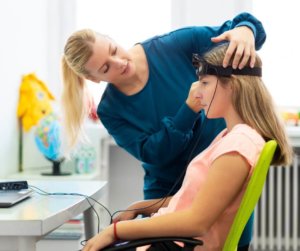
Neurofeedback clinics are a perfectly reasonable and effective way to manage and cope with a wide variety of mental wellness issues, including depression, ADHD, and autism.
However, at Healium, we cannot recommend a specific provider for anyone reading this blog. After all, we wouldn’t presume to know the ins and outs of your specific medical situation or the availability of neurofeedback centers in your specific area.
That being said, we’d love to offer you some advice on what to prioritize when considering all the available neurofeedback clinics near you :
1. Location: Obviously, proximity to your home will be a major factor, and while this seems like an obvious tip, it’s worth pointing out that this should carry even more added weight for neurofeedback clinics specifically because the effectiveness of neurofeedback therapy is tied closely to how regularly you conduct sessions.
In short: you’ll be driving to your chosen clinic a lot, so search for a neurofeedback center and practitioner who is located fairly near where you are based!
2. Specialization: There are different types of neurofeedback therapy, ranging from Quantitative EEG therapy to Alpha/Theta Neurofeedback. These specializations target and affect different brainwaves to achieve different results.
Make sure you’re knowledgeable about the different types of neurofeedback, as well as the different types of brainwaves and what they’re associated with when considering different neurofeedback practitioners.
3. Competence: Make sure that the practitioner and center are well-known for effective neurofeedback treatments and professional services. Read online reviews and ask for the honest opinions of friends and family who have tried the treatments of the practitioners you are considering.
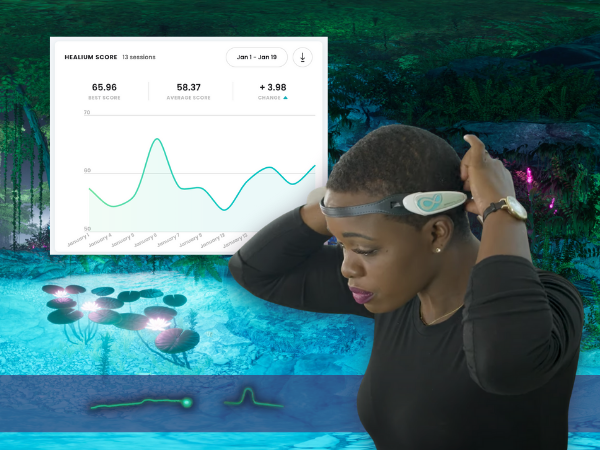
You can experience the benefits of neurofeedback therapy and increase your mental fitness by buying at-home neurofeedback equipment and trying neurofeedback yourself in a comfortable home environment!
Contact Healium to learn how our VR neurofeedback app and EEG headband can transform your mental fitness for the better.
{“@context”:”https://schema.org”,”@type”:”FAQPage”,”mainEntity”:[{“@type”:”Question”,”name”:”Is Neurofeedback Worth the Cost?”,”acceptedAnswer”:{“@type”:”Answer”,”text”:”In our humble opinion, yes, very much so! \n\nThere’s no getting around the fact that neurofeedback can be costly depending on the approach you take (whether or not you do neurofeedback at home or go to a professional neurofeedback clinic makes a big difference in total cost). However, the benefits that regular neurofeedback training can give you, especially when combined with immersive virtual reality meditation, are absolutely life changing and worth the investment. \n”}},{“@type”:”Question”,”name”:”How Much Does Neurofeedback Cost?”,”acceptedAnswer”:{“@type”:”Answer”,”text”:”This depends on if you’re trying to practice neurofeedback at home, or attend neurofeedback therapy in a clinical setting. For those practicing at home, equipment can cost as little as a few hundred dollars, with added expenses needed for access to neurofeedback tracking applications. \n\nProfessional neurofeedback therapy, meanwhile, will cost you into the thousands of dollars.”}},{“@type”:”Question”,”name”:”How Can You Do Neurofeedback at Home?”,”acceptedAnswer”:{“@type”:”Answer”,”text”:”Neurofeedback at home is easy to do with the right tools at your disposal. First, you’ll need a way to capture your brainwaves. EEG headbands like the Brainlink Lite EEG Headband are a great (and cost-effective) option. Secondly, you’ll need an app to provide real-time feedback as well as track your progress over time. Our virtual reality and augmented reality app Healium does just that!”}}]}
Sarah Hill, a former interactive TV news journalist at NBC, ABC, and CBS affiliates in Missouri, gained recognition for pioneering interactive news broadcasting using Google Hangouts. She is now the CEO of Healium, the world’s first biometrically powered VR/AR channel, helping those with stress, anxiety, insomnia, and other struggles through biofeedback storytelling. With patents, clinical validation, and over seven million views, she has reshaped the landscape of immersive media.
The benefits of neurofeedback are endless. Better sleep, increased concentration, impulse control, and more. But when we talk about “seeing your feelings”, what do we really mean and why is that important?
The first step in controlling your feelings is measuring them. Feelings have physiological effects on the body which are easily measured. For example, a calm feeling appears as slower brainwave activity in the frontal lobe and a lower heart rate.
Neuroscientists use an EEG cap to evaluate the electrical activity in the brain by placing electrodes on the scalp.
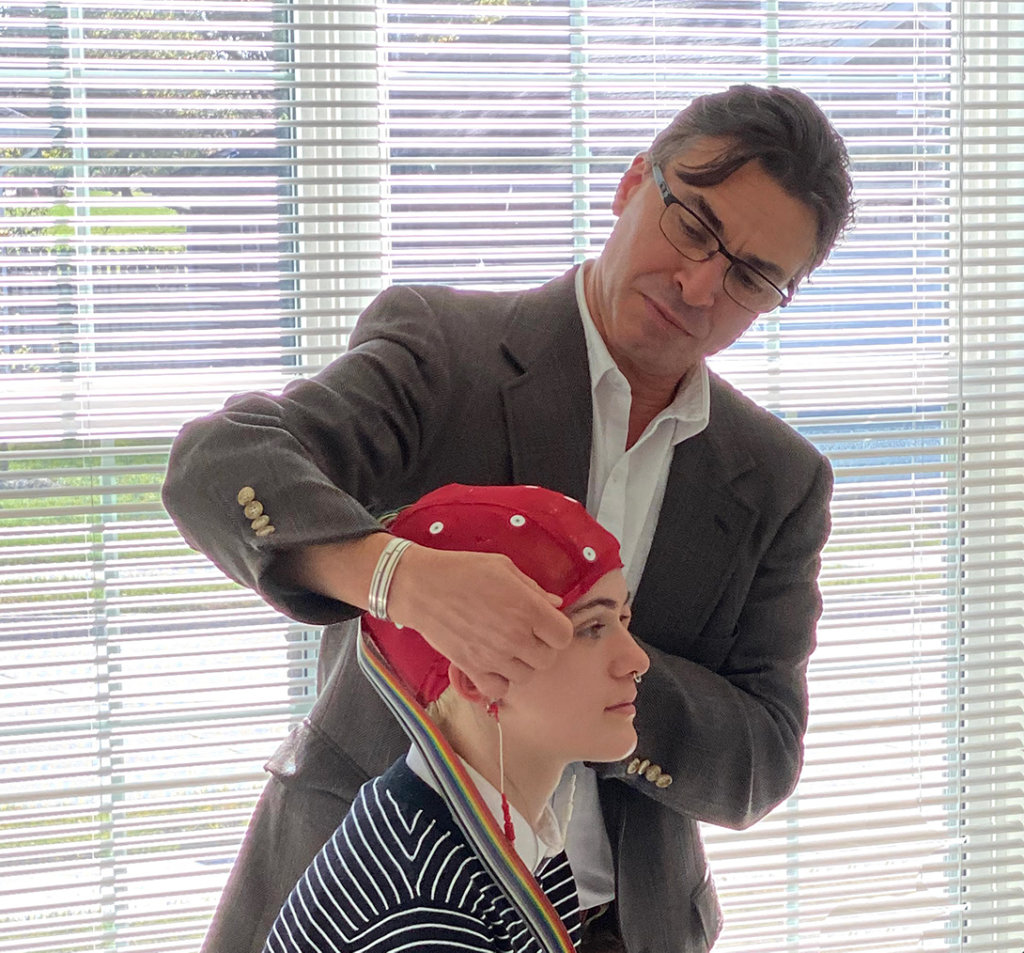
Luckily, consumer wearables, such as a BrainLink EEG headband, are more widely accessible in order to gather an overview of brain activity. While these consumer headbands cannot capture all areas of your brain like a full 19 sensor EEG cap, they can give you a helpful snapshot of your brain wave patterns, especially when paired with interactive or immersive media.
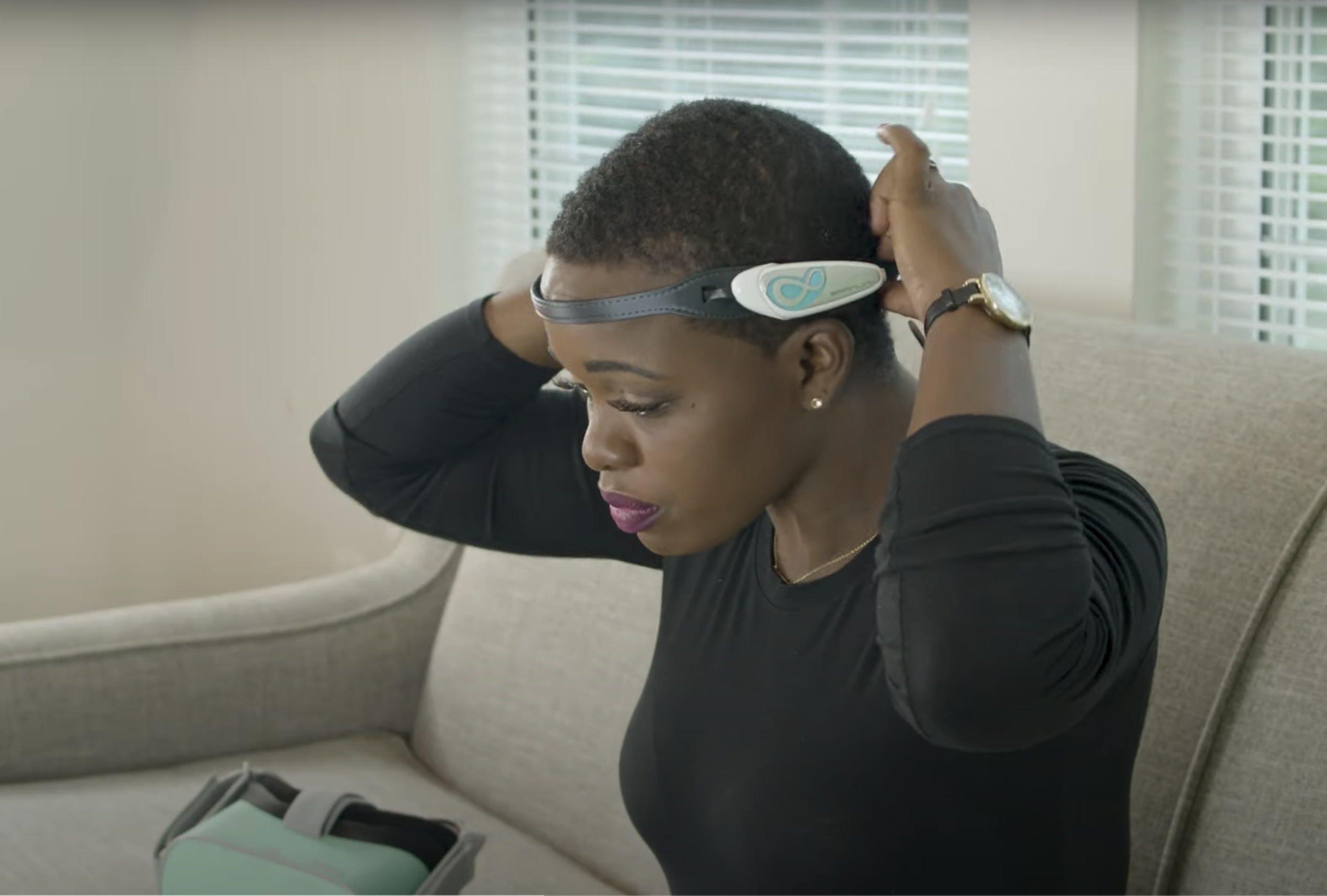
The headband has three sensors that are located on the strap that goes across your forehead, essentially monitoring your brain’s electrical activity. Through this neurofeedback connection, a representation of your brain patterns is displayed visually in near real-time within the Healium’s VR and AR apps.
To improve your focus, you want your slow brain waves (theta) to go down and your fast brain waves (beta) to go up. Ideally, the frontal lobe needs to be engaged.

To improve feelings of calm, you want the opposite; you’re trying to reduce fast, high beta activity in the frontal lobe.
The algorithm built into the app takes these ratios into account. Inside the Healium app, you’ll see a firefly go above the baseline when this criteria is met, meaning you’re successfully meeting the mark for focused calm when using the BrainLink, or a lowered heart rate when using the Apple Watch.
If you’ve ever attempted meditation or mindfulness before, you might have given in to the distractions around you or found it hard to focus.
With feedback displayed to you in real-time, you know whether or not you’re hitting the mark. Are you recalling a calm memory? Are you letting your mind wander? How are you responding to the experience and the story?
Feedback lets you know if the experience is working. This can lead to an advanced mindfulness practice with an enhanced awareness of your mind/body connection.
Below is an example of what you’ll see inside the virtual reality app when paired with a BrainLink EEG headband.
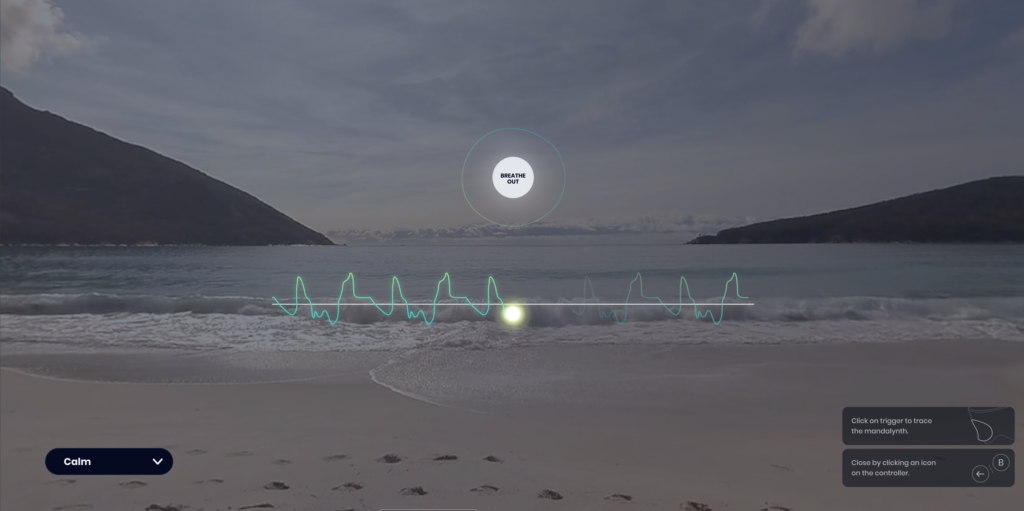
The ability to be guided back to the goal makes it attainable and encouraging when you’re doing well. Many Healium users report the same experience.
Ellen, a subscriber to Healium says, “Healium is my first real VR experience and it’s easy to use for what I call my own self-care. As someone who has managed with anxiety and depression my whole life, the experiences are calming, lovely, peaceful, and truly relaxing.”
As an added psychological boost, you’ll feel rewarded when you maintain your firefly above the baseline.
Interestingly, our perception isn’t always accurate. In a study conducted by the NeuroMeditation Institute, users reported how they felt before and after using the Healium AR app.
Everyone reported decreases in negative emotions and increases in positive emotions, regardless of whether they were using biofeedback or not. However, participants using biofeedback showed changes in their physiology whereas the other group didn’t.
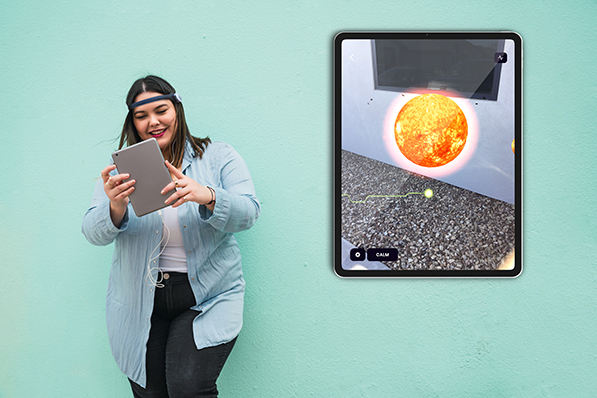
That’s where biofeedback can help improve your awareness of your feelings and your ability to influence them. What you’re thinking you’re feeling vs what you’re actually feeling isn’t always connected. Over time, this connection can grow stronger which can boost your mental resilience.
Feelings can be controlled. They don’t happen to us. But with biofeedback you can control anything you can measure. Remember that your thoughts have power…in the virtual world and in the real world as well.
Note: The data from a consumer wearable is not diagnostic. It is valuable as a self-awareness tool to better understand how your brain patterns and heart rate react to your thoughts.